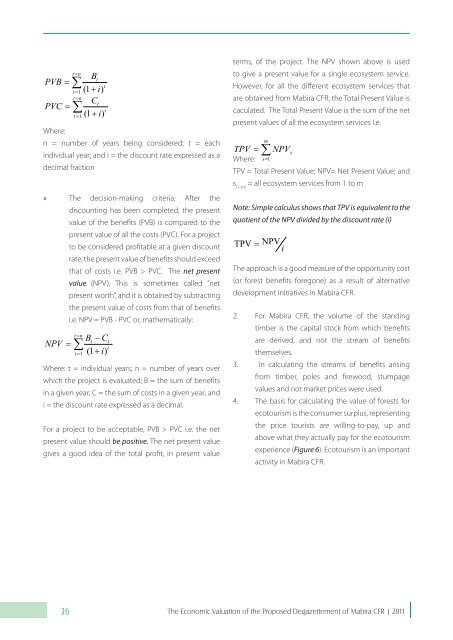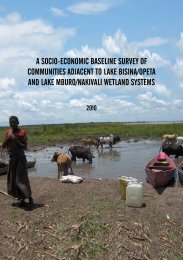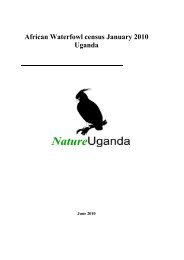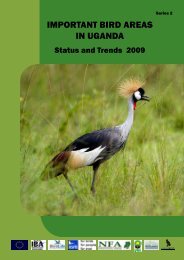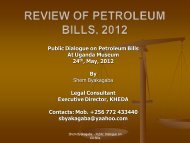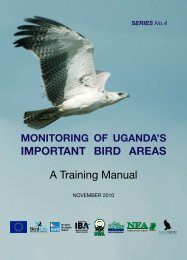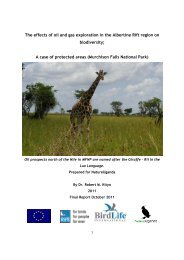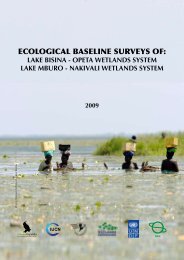the economic valuation of the proposed ... - Nature Uganda
the economic valuation of the proposed ... - Nature Uganda
the economic valuation of the proposed ... - Nature Uganda
You also want an ePaper? Increase the reach of your titles
YUMPU automatically turns print PDFs into web optimized ePapers that Google loves.
PVB =<br />
PVC =<br />
Where:<br />
36<br />
∑ = t n<br />
t = 1<br />
∑ = t n<br />
t = 1<br />
Bt<br />
t<br />
( 1+<br />
i)<br />
Ct<br />
t<br />
( 1+<br />
i)<br />
n = number <strong>of</strong> years being considered; t = each<br />
individual year; and i = <strong>the</strong> discount rate expressed as a<br />
decimal fraction<br />
» The decision-making criteria; After <strong>the</strong><br />
NPV<br />
=<br />
discounting has been completed, <strong>the</strong> present<br />
value <strong>of</strong> <strong>the</strong> benefits (PVB) is compared to <strong>the</strong><br />
present value <strong>of</strong> all <strong>the</strong> costs (PVC). For a project<br />
to be considered pr<strong>of</strong>itable at a given discount<br />
rate, <strong>the</strong> present value <strong>of</strong> benefits should exceed<br />
that <strong>of</strong> costs i.e. PVB > PVC. The net present<br />
value (NPV). This is sometimes called “net<br />
present worth”, and it is obtained by subtracting<br />
<strong>the</strong> present value <strong>of</strong> costs from that <strong>of</strong> benefits<br />
i.e. NPV = PVB - PVC or, ma<strong>the</strong>matically:<br />
∑ = t n<br />
t = 1<br />
Bt<br />
− Ct<br />
t<br />
( 1+<br />
i)<br />
Where: t = individual years; n = number <strong>of</strong> years over<br />
which <strong>the</strong> project is evaluated; B = <strong>the</strong> sum <strong>of</strong> benefits<br />
in a given year; C = <strong>the</strong> sum <strong>of</strong> costs in a given year; and<br />
i = <strong>the</strong> discount rate expressed as a decimal.<br />
For a project to be acceptable, PVB > PVC i.e. <strong>the</strong> net<br />
present value should be positive. The net present value<br />
gives a good idea <strong>of</strong> <strong>the</strong> total pr<strong>of</strong>it, in present value<br />
terms, <strong>of</strong> <strong>the</strong> project. The NPV shown above is used<br />
to give a present value for a single ecosystem service.<br />
However, for all <strong>the</strong> different ecosystem services that<br />
are obtained from Mabira CFR, <strong>the</strong> Total Present Value is<br />
caculated. The Total Present Value is <strong>the</strong> sum <strong>of</strong> <strong>the</strong> net<br />
present values <strong>of</strong> all <strong>the</strong> ecosystem services i.e.<br />
TPV =<br />
Where:<br />
m<br />
∑ NPVs<br />
s=<br />
1<br />
TPV = Total Present Value; NPV= Net Present Value; and<br />
s (1-m) = all ecosystem services from 1 to m<br />
Note: Simple calculus shows that TPV is equivalent to <strong>the</strong><br />
quotient <strong>of</strong> <strong>the</strong> NPV divided by <strong>the</strong> discount rate (i)<br />
TPV = NPV<br />
i<br />
The approach is a good measure <strong>of</strong> <strong>the</strong> opportunity cost<br />
(or forest benefits foregone) as a result <strong>of</strong> alternative<br />
development initiatives in Mabira CFR.<br />
2. For Mabira CFR, <strong>the</strong> volume <strong>of</strong> <strong>the</strong> standing<br />
timber is <strong>the</strong> capital stock from which benefits<br />
are derived, and not <strong>the</strong> stream <strong>of</strong> benefits<br />
<strong>the</strong>mselves.<br />
3. In calculating <strong>the</strong> streams <strong>of</strong> benefits arising<br />
from timber, poles and firewood, stumpage<br />
values and not market prices were used.<br />
4. The basis for calculating <strong>the</strong> value <strong>of</strong> forests for<br />
ecotourism is <strong>the</strong> consumer surplus, representing<br />
<strong>the</strong> price tourists are willing-to-pay, up and<br />
above what <strong>the</strong>y actually pay for <strong>the</strong> ecotourism<br />
experience (Figure 6). Ecotourism is an important<br />
activity in Mabira CFR.<br />
The Economic Valuation <strong>of</strong> <strong>the</strong> Proposed Degazettement <strong>of</strong> Mabira CFR | 2011


